Joy Neal Kidney's Blog, page 43
January 23, 2023
This Journaled Prayer from 2004
Leora’s Letters wouldn’t be published until fifteen years later, but I journaled this prayer for the book in August 2004, as part of a local Creativity, Vision, and Faith Class from artist Mike Brangoccio:
“Dale–New Guinea. [I have no idea why I began with Dale Wilson that day.] Please, Lord God, be in the writing. Actually I need you in the thinking, how it will take shape. Make me sensitive to themes & nuances & how to make sure this family’s sacrifices are never forgotten. [Five Wilson brothers served. Only two came home.]
“But help me to paint them not as saints but as ordinary people trying to do the right thing. Help me to discover why this is important, why strangers will want to read it, why they will remember.
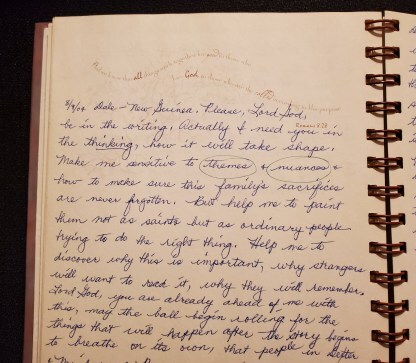 “Lord God, you are already ahead of me with this, may the ball begin rolling for the things that will happen after the story begins to breathe on its own, that people in Dexter & Minburn & Perry will become part of the team that won’t let their memory die. I cannot do this on my own, Lord. The story is too huge & unwieldy, but last weekend somehow you got my anxiety over the hump.
“Lord God, you are already ahead of me with this, may the ball begin rolling for the things that will happen after the story begins to breathe on its own, that people in Dexter & Minburn & Perry will become part of the team that won’t let their memory die. I cannot do this on my own, Lord. The story is too huge & unwieldy, but last weekend somehow you got my anxiety over the hump.
“Help me to successfully place Dale’s history in the history he joined up with & was sucked into. Help me to weave the words in such a way that the story becomes important to strangers. Lord God, I don’t know what that means, but as I endeavor to put it down on paper, at some point please take over & turn the story into what you’ve intended for it.
“I sense something sacred here & am grateful to be the one to work on it. May I make wise decisions about the story & even what to do with the letters & other artifacts. Lord God, you know what I seek, what I mean about wanting the story to float ‘above the ground.’
“Help me to find whatever it is for the Wilson story. It comes from the heart & thinking. I need the details & the research, but this other has to do with how I end up telling the details and research.
“Lord God, weave that into my heart & thinking even as I review these details & research!”
This was nearly the last writing in the little journal, as I sank farther into the misery of fibromyalgia.
I had attended several workshops during the University of Iowa Summer Writing Festivals during the 1990s, but it wasn’t until 2016 that I was able attend the Cedar Falls Christian Writers Workshop.
Two years later, I joined the online group, Write That Book (now Write That Book With Tricia Goyer), where I connected with one of the presenters, Robin Grunder. She became my coauthor for Leora’s Letters, which was published in late 2019, an answer to that long-ago prayer.
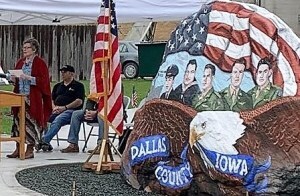 About the same time, the Wilson brothers were remembered at the dedication of the Dallas County Freedom Rock at Minburn, Iowa, near where they’d been tenant farmers with their dad before and during the war.
About the same time, the Wilson brothers were remembered at the dedication of the Dallas County Freedom Rock at Minburn, Iowa, near where they’d been tenant farmers with their dad before and during the war.
A nearby storyboard shares the details of their service, and the losses of three of the five.
I’m still amazed and humbled by these answers to prayer so many years later, along with two more “Leora books” published since then. But it began long ago with a dream and many prayers, several of which were journaled.
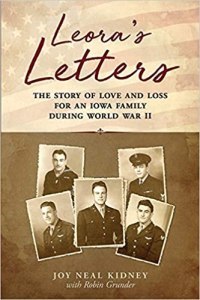
January 20, 2023
The Iowa Chemist Who Saved the Manhattan Project
Wilhelm’s Way
by Teresa Wilhelm Waldof
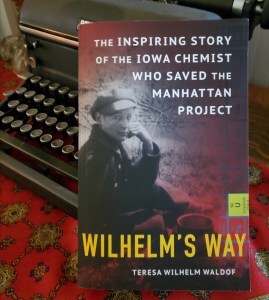 The Book
: The untold story of the humble man whose scientific innovation helped end World War II
The Book
: The untold story of the humble man whose scientific innovation helped end World War II
In February 1942, leaders of the Manhattan Project had a problem: to prove a controlled nuclear chain reaction was possible, they needed pure uranium—tons of it and in less than ten months. With only a few grams in existence, there was little hope anyone could achieve such a feat. Harley Wilhelm, a chemistry professor at Iowa State College, rose to the challenge.
A sharecropper’s son and former college basketball coach, Wilhelm was an unlikely character to impact the course of world history. Nevertheless, he and his small, dedicated team of scientists and technicians surpassed anyone’s wildest expectations.
Wilhelm’s Way reveals the life and times of this unsung hero who helped America win the race to build the atomic bomb and end World War II.
 The Author: Teresa Wilhelm Waldof is the world’s leading expert on the Ames Project section of the Manhattan Project. An independent scholar, her in-depth research provides for trade publication the first-ever account of the life of chemist Harley Wilhelm and the critical Manhattan Project work he led on the Iowa State campus.
The Author: Teresa Wilhelm Waldof is the world’s leading expert on the Ames Project section of the Manhattan Project. An independent scholar, her in-depth research provides for trade publication the first-ever account of the life of chemist Harley Wilhelm and the critical Manhattan Project work he led on the Iowa State campus.
Teresa speaks on her grandfather’s life and scientific contributions, the Ames Project, and the founding of Ames Laboratory. Recent speaking engagements include the 75th Anniversary of Ames Laboratory, Iowa State University Lecture Series, and the American Chemical Society Annual Convention – Midwest Region.
Outside of research and writing, Teresa is a business professional with thirty years’ experience in management, specializing in process improvements and turn-arounds. Her methods VACIP© and DRIP© can be applied to improving results in business as well as achieving goals in life.
Teresa holds a BA in speech communications and an MBA from the University of Minnesota. She lives in Rochester, Minnesota, with her family.
My Thoughts: This is a story important to world history, to WWII history, to Iowa history, to the history of Iowa State University. But it’s also a masterfully written family story of the humble man who indeed influenced the outcome of WWII.
Please check out Teresa Wilhelm Waldof’s website.
January 18, 2023
The Honeymoon is Over by Rick Friday
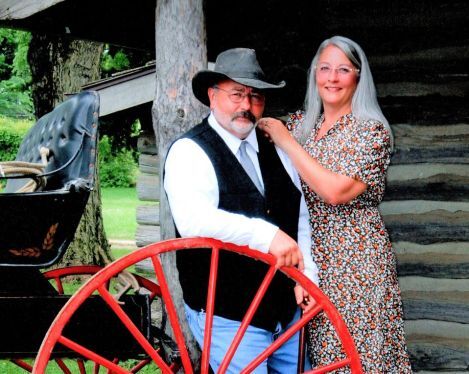 Rick and Juanita Friday
Rick and Juanita FridayLike any profession there are many do’s and don’ts to consider when working with your spouse. Experience is always the better teacher and the lessons I’ve learned while working with my wife on the farm are usually what you don’t want to do.
I hope what I am about to share will keep newlyweds from tearing up their wedding vows after working together on the farm. Cows are dumb, your wife is not. While working cattle with the love of your life it’s better to have bite marks on your tongue than to have them on your backside. If you mess up and yell at your wife she will undoubtedly go back to the house, leaving you alone to realize that you are now dumber than a cow.Do not expect your wife to know what you’re thinking. Be specific with your goal. You might be a whiz at problem solving, but she’ll kick your butt in multi-tasking all day long. I have learned that it is less lethal to share a plan with your wife. This way you can both say “Would’ve, Could’ve and Should’ve,” rather than you blaming her when your plan fails. Nothing turns anger into regret faster than a cursing tongue. If you mess up, she will undoubtedly go back to the house, leaving you alone to realize that you are now the weakest link in the chain of command.When giving directions to your wife, don’t be overly specific with details. Most of the time a man’s old fashion backwoods rural redneck directions don’t fit a woman’s gene map. When giving your wife directions to where she can find you in the field, try to avoid the four cardinal directions: North, South, East and West. Do not use landmarks that no longer exist or locations where events happened before you met her. A woman’s temperature rises dramatically when she’s lost. If she has to continually ask you “Which way’s East?,” she will undoubtedly go back to the house, leaving you alone to realize that it’s the same distance whether you drive or walk; it just takes a little longer if you have to walk.A man has a limited number of sorrys he can use in his lifetime, so he should use them wisely. I’m quite certain my wife keeps a tally.Rick Friday—–Here’s couple more Rick Friday stories.January 17, 2023
Free Leora eBooks Through Saturday

It’s true! Click here to order and download.
January 16, 2023
A Bright and Blinding Sun, a Story from WWII by Marcus Brotherton
A Bright and Blinding Sun
by Marcus Brotherton
The Book
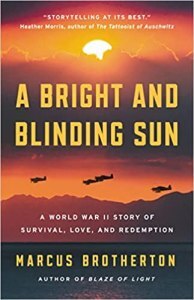 Joe Johnson Jr. ran away from home at the age of 12, hopping a freight train at the height of the Great Depression. He managed to talk his way into the U.S. Army two years later. Seeking freedom and adventure, he was sent to the Philippines.
Joe Johnson Jr. ran away from home at the age of 12, hopping a freight train at the height of the Great Depression. He managed to talk his way into the U.S. Army two years later. Seeking freedom and adventure, he was sent to the Philippines.
Adrift in spirit, Joe visited a teenage prostitute, and they became unlikely, smitten allies. Yet when the Japanese attacked on December 8, 1941, their hopes of being together had to wait.
Joe and his fellow soldiers fought for four brutal months in Bataan and Corregidor, until they were forced to surrender. The boy endured years of horror as a prisoner of war, only dreaming about seeing again the girl he’d come to love.
This lyrically written and deeply encouraging saga will remind you that every life can be lifted, forgiveness is the patron of restoration, and redemption is available to all.
The Author
 Marcus Brotherton is a New York Times bestselling author and coauthor dedicated to writing books that inspire heroics, promote empathy, and encourage noble living. Four of Marcus’ books are New York Times bestsellers, five are national bestsellers, four have been optioned for movies, two have received Booklist Starred Reviews, and one is an international bestseller. His books have also appeared on USA Today, Publisher’s Weekly, Wall Street Journal, and ECPA bestseller lists. Born in British Columbia, Marcus earned a bachelor’s degree from Multnomah University in Portland, Oregon, and a master’s degree from Biola University in Los Angeles, where he graduated with high honors. He lives with his wife and their three children in the Pacific Northwest.
Marcus Brotherton is a New York Times bestselling author and coauthor dedicated to writing books that inspire heroics, promote empathy, and encourage noble living. Four of Marcus’ books are New York Times bestsellers, five are national bestsellers, four have been optioned for movies, two have received Booklist Starred Reviews, and one is an international bestseller. His books have also appeared on USA Today, Publisher’s Weekly, Wall Street Journal, and ECPA bestseller lists. Born in British Columbia, Marcus earned a bachelor’s degree from Multnomah University in Portland, Oregon, and a master’s degree from Biola University in Los Angeles, where he graduated with high honors. He lives with his wife and their three children in the Pacific Northwest.
My Thoughts
What a powerful story, masterfully woven, about a too-young soldier who ends up in the Philippines nine months before WWII arrived. Joe spent five months fighting the Japanese on Bataan and Corregidor, 3 1/2 gruesome years as a POW. Bookending this important part of history is Joe’s relationship with a too-young prostitute, whom he manages to rescue, and how Joe eventually recognizes God’s work even during devastating months. A compelling redemption story. Highly recommended.
I’m always drawn to the backmatter of a book, whether nonfiction or historical nonfiction, where you learn the details about how the author discovered and utilized sources. The writing in A Bright and Blazing Sun is so well woven. It was a delight to learn that Joe Johnson, with only a 7th grade education, had written two versions of his memoirs, one in third person. Marcus Brotherton said that Joe wrote with lyricism, with “fresh twists on words and phrasing,” and that he came to appreciate Joe Johnson as a warrior-poet.
—–
I didn’t realize that two books I’d featured three other books with Marcus Brotherton’s fingerprints on them. He contributed substance and line edits to Adam Makos’s A Higher Call: An Incredible True Story of Combat and chivalry in the War-Torn Skies of World War II.
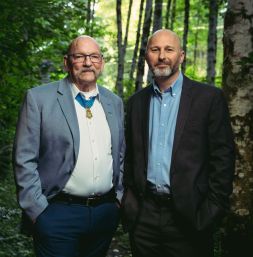 Gary Beikirch (1947-2021) and Marcus Brotherton in 2019
Gary Beikirch (1947-2021) and Marcus Brotherton in 2019Marcus Brotherton also wrote Blaze of Light, about Gary Beikirch, a Green Beret Medic in Vietnam and recipient of the Medal of Honor.
Gary Sinise’s Grateful American was written with Brotherton’s expertise. What a rich legacy!
Also Marcus was a writing partner on Adam Makos’s incredibly poignant Korean War story, Devotion, which I read and reviewed (Amazon, Goodreads, and BookBub). All of these books are so compelling.
Please check out Marcus Brotherton’s website. What a legacy of significant stories!
January 13, 2023
Chad Elliott: Iowa’s Renaissance Man
I’d planned to post this for National Poetry Month, but Chad Elliott has a Kickstarter campaign right now for a wonderful space in Jefferson, Iowa, for his own art studio. He’s offering several paintings, etc., as fundraisers for it. Please check it out!
Chad Elliott, Musician
 Midwest singer-songwriter Chad Elliott blends folk roots, swampy blues and soulful writing to deliver an original Americana sound. His live performances have been honed over a decade of being on the road performing more than 200 shows each year. Elliott is lauded as “Iowa’s Renaissance Man” by Culture Buzz Magazine. He has penned more than 1,500 songs in his career while also cultivating his skills as a painter, sculptor, illustrator and author.
Midwest singer-songwriter Chad Elliott blends folk roots, swampy blues and soulful writing to deliver an original Americana sound. His live performances have been honed over a decade of being on the road performing more than 200 shows each year. Elliott is lauded as “Iowa’s Renaissance Man” by Culture Buzz Magazine. He has penned more than 1,500 songs in his career while also cultivating his skills as a painter, sculptor, illustrator and author.
Chad Elliott, Poet
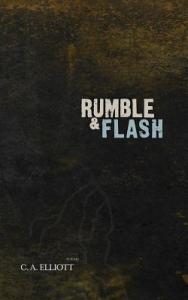
Chad Allen Elliott’s path to poetry began with a love of music. He has performed original songs across the U.S. for over 20-years, winning several awards for composition including the Woody Guthrie Songwriting Award in 2009. Early in his career, he learned some verses do not need musical embellishment. They stand alone in their own cadence. Since that time, Elliott has penned nearly 2,000 songs and released 22 albums.
In Rumble & Flash, Elliott shares poems composed during his time on the road. These poems are steeped in archetypal themes like fatherhood, love, nature, and spirituality.
My thoughts: This is one of my favorite books of poetry. I especially like “The Rough Aesthetic of Men,” “One Harmful Thing,” “Refining Years,” and “Bur Oak.”
Chad Elliott, Artist
 Elliott is a graduate of Graceland University in Lamoni, Iowa, with a bachelor of arts in ceramics and has since collected graduate credits from the University of Montana in Missoula.
Elliott is a graduate of Graceland University in Lamoni, Iowa, with a bachelor of arts in ceramics and has since collected graduate credits from the University of Montana in Missoula.
At the Guthrie Grove Camp in Guthrie Center, Iowa, Elliott has created murals with youth. He has also created large murals for businesses including Shaky Tree Coffee and Farmers Trust & Savings Bank both in Spencer, Iowa. His recent mural work includes two 5 foot by 12 foot canvas paintings installed in 2012 in the newly renovated Spencer Community Theatre. He also completed a 16 foot by 40 foot landscape mural in 2013 on the side of Mohr Lumber in Coon Rapids, Iowa, to commemorate the town‘s sesquicentennial. In Pampa, Texas, Elliott installed a mural titled “This Land is Your Land” at the Woody Guthrie Folk Music Center.
Currently he completes commission work from Elliott Art Studio in his home in Lamoni, Iowa. This year, he will be painting a mural for his hometown of Guthrie Center, Iowa.
Please check out Chad’s Art Studio website.
Also his Music website
January 11, 2023
Letter from the Daughter of Alonzo Wilson of Coon Rapids, Iowa
Wilda Wilson Davis was a first cousin to Clabe Wilson. Her father, Alonzo, was a brother of Clabe’s father, Daniel Ross Wilson. Daniel’s twin brother didn’t survive.
—–
Keyes, California, Dec. 23, 1941
Dear Cousin [Wilda Wilson Davis to Rectha Wilson Kansgen, who was Clab Wilson’s sister],
Edna [Wilda’s sister] and I were in La Junta in ’20 or ’21 she taught there a year and we were in Cimarron one Sunday had no idea we had relatives there. . . .
You asked about the Wilsons. Well, I think we can proudly say Grandpa [Samuel] Wilson was Betsy Ross’s grandson, for [her] father’s name was Daniel Ross Wilson. I don’t suppose you remember Grandpa [Sam] or his sisters Aunt Betsy Ross (Wilson) Durlam. They lived near Glidden, Ia. Scotch, Irish descent.
Grandma [Emily] was Holland Dutch her name was Hyke, her father was a doctor, they both came from New York state and went back for a visit in the 80s – Grandpa & Grandma came to Iowa in 1854 from Joliet, Ill. when my father Lon Wilson (was born at Joliet) was 8 years old.
Grandpa [Sam Wilson] was a government agent to the Indians for some years and his headquarters was at Fort Omaha the city was just a village then. They crossed the river on the ice with water running to the hubs on one late winter with supplies from Marshalltown.
Uncle Dick Wilson learned to walk while they were on the reservation, he was born on Brushy Creek, their nearest white neighbors were 24 miles away at Panora, Iowa – I have heard my father & grandma tell some stirring tales to send prickles up your spine.
As Ever, Your Cousin Wilda
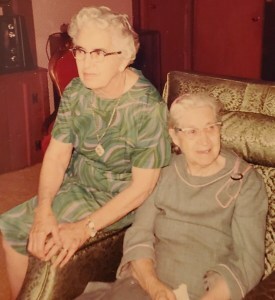 Leora Wilson with Wilda Wilson David, a cousin of Clabe Wilson’s. San Jose, California, March 18, 1969.
Leora Wilson with Wilda Wilson David, a cousin of Clabe Wilson’s. San Jose, California, March 18, 1969.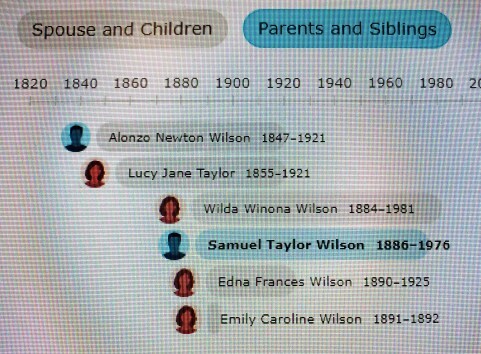 Their children were first cousins of Clabe Wilson, who was born in 1888.
Their children were first cousins of Clabe Wilson, who was born in 1888.—–
I haven’t been able to find any relationship to Betsy Ross, even though the name Ross has been passed down through at least two branches of the family. How did this notion even get started?
I don’t think that Sam Wilson was an official Indian agent, but his background would certainly have made him useful to officials. Oh! Don’t you wish they’d written down some of those “stirring tales to send prickles up your spine”!
I believe that Alzono (Lon) Wilson’s land is now part of the Whiterock Conservancy in Coon Rapids, Iowa.
The Wilson burial plot is at Coon Rapids, Iowa, east side of the hilly cemetery, about halfway toward the north. The cemetery has many old Bur Oak trees. The Wilson farmland was just east of the cemetery.
Clabe Wilson used to ice skate up the river from Guthrie County to visit his widowed grandmother there.

January 9, 2023
The Wilson Connection to the White Rock Conservancy at Coon Rapids, Iowa
Heater House was center for hard work and good fun
 “Editor’s Note – Another feature written by Liz Garst, this story centers on the “Heater House”, now known as the “River House“, located south and east of Coon Rapids beside the Raccoon River. Mrs. Henry (Clarice) Shirbroun, shared some of her memories about the Heater house. She moved there with her parents, Clarence and Agnes Heater, when she was 10 years old.
“Editor’s Note – Another feature written by Liz Garst, this story centers on the “Heater House”, now known as the “River House“, located south and east of Coon Rapids beside the Raccoon River. Mrs. Henry (Clarice) Shirbroun, shared some of her memories about the Heater house. She moved there with her parents, Clarence and Agnes Heater, when she was 10 years old.
“Clarence and been farming north of town on rented land. He wanted a place of his own, so he bought what is now known as the Heater House and 80 acres. Then it was known as the Sam Wilson place. Sam had purchased it from his father, Lawn (Lloyd) Wilson. [I believe this was Alonzo (or Lon) Wilson, son of Carroll County pioneers Samuel and Emily Wilson.] Part of the deal was another 80 acres, one and one half miles northeast. . . . They moved onto the place in 1926.
“The Wilsons left many out buildings, including pig pens, chicken sheds, the barn, the outhouse, and an ice house. The screened porch wrapped the first floor of the frame house on a stone and cement foundation. The house didn’t have many windows. The stairs were enclosed, and the basement unfinished. A spring northeast of the house had been channeled to pass under the first floor kitchen. A dumb waiter ferried butter, milk and, occasionally, jello to the waters of the cool, running spring. Clarice said it wasn’t handy. Fighting the crank and the weight of the platform and food, it was hard not to spill the jello. Merle Shirbroun remembers exploring the spring by dumb waiter with his brother, Darrell. A tamer route was through a basement crawl door.
“The Wilsons had planted a large orchard north of the house. The varieties aren’t common today – bit Wolf Rivers and Greening apples, which tasted like a banana. There were also pears and plums. The road of that day ran parallel to, but west of today’s road. It cut much closer to the house, bending sharply to find the bridge. The river also divided the farm.”
Coon Rapids Enterprise, September 3, 1987
 This 1875 map shows pioneer Samuel Wilson’s land just to the east of Coon Rapids.
This 1875 map shows pioneer Samuel Wilson’s land just to the east of Coon Rapids.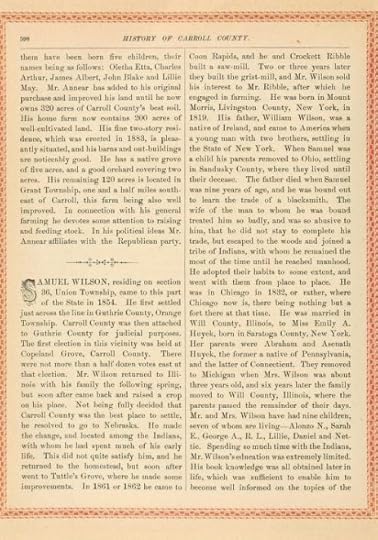 1887 Biographical and Historical Record of Green and Carroll Counties, Iowa, published while Sam Wilson was still living, names his living children, including Alonzo N. and Daniel. For some reason, this page shows up better on an earlier post.
1887 Biographical and Historical Record of Green and Carroll Counties, Iowa, published while Sam Wilson was still living, names his living children, including Alonzo N. and Daniel. For some reason, this page shows up better on an earlier post.
January 6, 2023
Leora’s Dexter Stories: The Scarcity Years of the Great Depression – List of Chapters
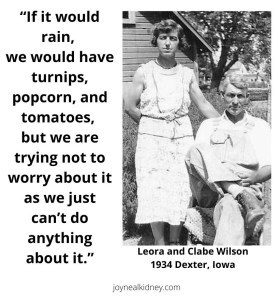 “Easy read that gives a realistic picture of life in Central Iowa during the Great Depression. You will find yourself cheering for Clabe & Leora at every turn. A great read aloud for children & grandchildren that lends itself to countless teachable moments.” – S. D. Vannoy, Amazon Customer
“Easy read that gives a realistic picture of life in Central Iowa during the Great Depression. You will find yourself cheering for Clabe & Leora at every turn. A great read aloud for children & grandchildren that lends itself to countless teachable moments.” – S. D. Vannoy, Amazon Customer
The Wilson family slowly slides into unemployment and poverty. Leora must find ways to keep her dreams alive while making a haven for her flock of seven children in one run-down house after another.
I kept chapters short, in hopes that students will also enjoy reading these stories. I certainly wish I’d discovered a book like this one when I was a student!
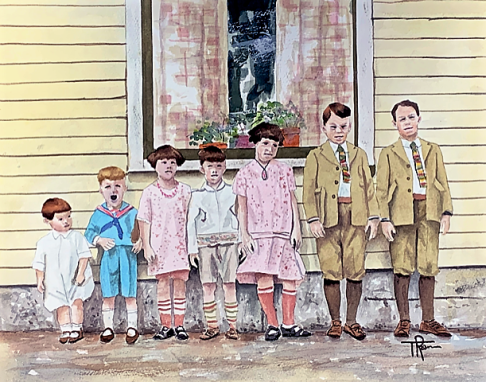 Original watercolor by Tim Ross, an Audubon County, Iowa, native, now an agricultural meteorologist for RFD-TV, Nashville. The original snapshot, on page 2 of Leora’s Dexter Stories, was taken in 1927 along Old Creamery Road, south of Dexter in Penn Township, Madison County, Iowa. I grew up less than a mile south of where this was taken.
Original watercolor by Tim Ross, an Audubon County, Iowa, native, now an agricultural meteorologist for RFD-TV, Nashville. The original snapshot, on page 2 of Leora’s Dexter Stories, was taken in 1927 along Old Creamery Road, south of Dexter in Penn Township, Madison County, Iowa. I grew up less than a mile south of where this was taken.Tim Ross’s website “Timbits.”
Here are the names of the chapters in Leora’s Dexter Stories: The Scarcity Years of the Great Depression:
Chapter 1--Danny’s EaracheChapter 2--Mastoidectomy
Chapter 3--Penn Township
Chapter 4--Independence Day at Dexfield Park
Chapter 5--Acreage at the Edge of Dexter
Chapter 6--Clabe’s Stories
Chapter 7--The Cow Dries Up
Chapter 8--Whooping Cough
Chapter 9--Decoration Day
Chapter 10--Husky and the Pack of Dogs
Chapter 11--Paving of the Great White Way
Chapter 12--1930
Chapter 13--Grandpa’s Heart Attack
Chapter 14--Guilt and Consolation
Chapter 15--Clabe’s Surgery
Chapter 16--The Sheepshed
Chapter 17--Yet Another Move
Chapter 18--First High School Graduates
Chapter 19--Delbert to California
Chapter 20--Bonnie and Clyde
Chapter 21--A Biplane Ride Before School
Chapter 22--Delbert and Donald Join the Navy
Chapter 23--Running the Town Pump
Chapter 24--Machine Perm in Redfield
Chapter 25--Rusty the Pet Squirrel (Rusty is on the cover of the book)
Chapter 26--The Panama Canal
Chapter 27--A Suspicion Before Christmas
Chapter 28--The Imbedded Needle
Chapter 29--Goffs Move to Omaha
Chapter 30--Gossip
Chapter 31--Clabe Becomes a Hobo
Chapter 32--Spats
Chapter 33--The Canning Factory
Chapter 34--New Deal Jobs
Chapter 35--’Possum for Birthday Dinner
Chapter 35--Blizzards
Chapter 37--Basketball Tourney
Chapter 38--Pollywogs Become Shellbacks
Chapter 39--Another Dexter High School Diploma
Chapter 40--California Visitors
Chapter 41--American Institute of Business
Chapter 42--Discharged from the Navy
Chapter 43--California Jobs Fizzle
Chapter 44--Bounty for Starlings
Chapter 45--Dallas County Champs
Chapter 46--Minburn and More Graduates
Chapter 47--Leora
Afterword: How I Learned Everything
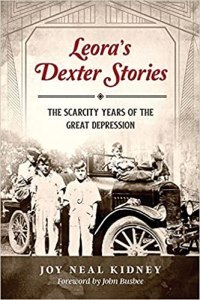
January 4, 2023
Tonsillectomies, 1951
Tonsillectomies were evidently routine in the 1950s, at least for kids ages about ages 4 to 6. There were certainly several children listed in the hospital news the winter of 1950-51. From the January 4, 1951, Dexter Sentinel:
“Robert Gist of Earlham, Terry Byrne of Earlham, Luretta Lilly of Dexter, Phyllis Miller of Stuart, Joy and Jean Neal of Dexter, Susan Shepherd of Dexter, Bobby Harris of Casey and Bruce Lawson of Dexter underwent tonsillectomies at the clinic hospital this week.
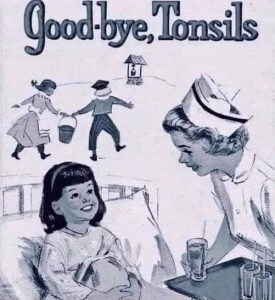
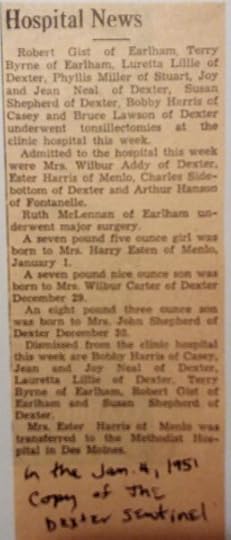 “Admitted to the hospital this week were Mrs. Wilbur Addy of Dexter, Ester Harris of Menlo, Charles Sidebottom of Dexter and Arthur Hanson of Fontanelle.
“Admitted to the hospital this week were Mrs. Wilbur Addy of Dexter, Ester Harris of Menlo, Charles Sidebottom of Dexter and Arthur Hanson of Fontanelle.
“Ruth McLennan of Earlham underwent major surgery.
“A seven pound five ounce girl was born to Mrs. Harry Esten of Menlo January 1.
“A seven pound nice [sic] ounce son was born to Mrs. Wilbur Carter of Dexter December 29.
“An eight pound three ounce son was born to Mrs. John Shepherd of Dexter December 30.
“Dismissed from the clinic hospital this week were Bobby Harris of Casey, Jean and Joy Neal of Dexter, Lauretta Lillie of Dexter, Terry Byrne of Earlham, Robert Ohrt of Earlham and Susan Shepherd of Dexter.”
My sister, Gloria Jean, was called by her middle name until kindergarten, where there were more Jeans and Janes in the class. Mom asked her if she’d like to be called Gloria, She did.
First cousin Susan Shepherd was 5, Gloria 4, and I was 6 when we underwent tonsillectomies. I still remember the smell of ether, and getting to have ice cream when we got home.
Susan’s mother was Mrs. John Shepherd in the clipping. Susan’s baby brother was born while Susan was also in the hospital!



